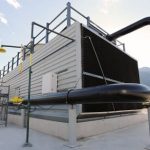California’s Housing Crisis And Long Commutes Are Slowing Its Progress On Climate
Jerry Brown, the governor of California, is not one to be cowed by federal backtracking on environmental regulations. His promise back in December that California “will launch its own damn satellites” should Trump defund the NASA operations that track climate change has become something of a rallying cry for the environmental resistance.
California should hold onto that stubbornness. The state has long been a leader in environmental policy and strong economic growth, but to keep both categories trending upward amid a retrograde national framework, it will have to double down on innovation and what San Francisco-based nonprofit Next 10‘s founder F. Noel Perry describes as “climate policy 2.0”–which means tackling the state’s housing and transportation woes.
For the past nine years, Next 10 has released an annual report entitled the California Green Innovation Index, which tracks the state’s economic growth alongside its environmental policies. Over the course of the report’s existence, Perry’s organization has tracked how California’s per-capita GDP has grown by around $5,000 per person–nearly double the national rate–and its emissions have dropped by 12%. Job growth, in that time frame, exceeded national rates by 27%, largely driven by developments in the tech sector. This year, the report, developed in collaboration with Beacon Economics, a California-based research and consulting firm, reinforces how the state’s progressive environmental policies have grown alongside the economy–a dynamic that flies in the face of arguments favored by Donald Trump, who prefers to believe that clean energy equates to economic destruction. But the 2017 California Green Innovation Index also shows that the effects of the state’s efforts to support innovation and implement carbon-reduction policies are reaching a plateau–and issues a call for the public and private sectors to step up their game.

Under Assembly Bill 32, passed in 2006, California set itself the goal of reducing emissions to 1990 levels by 2020. The state is aiming for a 40% reduction below 1990 levels by 2030, and 80% by 2050–the year the state legislature is currently debating setting as the deadline to convert to 100% renewable energy. Under California’s cap-and-trade program, which attaches a price to carbon and sets a limit on the amount that can be released by polluting industries, emissions have gone down. But in 2015, emissions dropped only .34%. In order to meet the 2050 climate goal, emissions will have to drop by 4.97% each year between 2020 and 2030, and even more sharply for the subsequent two decades.
For the state that was the first in the nation to adopt energy efficiency policies on everything from buildings to televisions, it may seem a difficult task to pinpoint where exactly there’s room to create more emissions-curbing regulations. It’s not. It’s the transportation sector.
Transportation accounts for 38.5% of the state’s total greenhouse gas emissions, according to the report; transportation-related GHG actually increased 2.7% in 2015, likely due to lower gas prices and the state’s economic boom. “When the economy is doing well, people have jobs and people drive more,” Perry tells Fast Company. So there is, on the one hand, the Silicon Valley-esque elite class, who may be hopping in single-occupancy vehicles and speeding away on weekend trips. But that’s hardly the whole picture. The same forces that have created economic epicenters like Silicon Valley in the state have also precipitated a crisis in the housing market’s inability to keep up with demand, and that has pushed employees further and further away from where it is that they actually work.
While Silicon Valley is but one slice of California, it’s instructive to focus on it when talking housing and transportation issues. The workforce there is not one for carpooling: Around 75% of employees in the region drive themselves to work solo, and just over a quarter of office developments in the Bay Area lie within a half mile of a node in the region’s woefully inadequate public transportation network. With counties like San Mateo and Santa Clara adding only 22,000 units in the face of 167,000 new jobs between 2010 and 2014, lower-income workers have gone in search of affordable housing–often more than 100 miles away–in areas that aren’t served by public transit. By 7 a.m., the region’s roads are a gridlocked hell.
This is the knot that needs to be unraveled in order for the state to progress on its climate and economic goals, says Adam Fowler, a research manager at Beacon Economics who worked on the report. “Until we increase the housing supply, this issue is only going to compound,” Fowler says. Developing a more robust housing and transportation infrastructure will both create jobs, and enable more jobs to remain in the state’s economic centers. And alongside those shifts, California needs to aggressively pursue a shift to zero-emissions vehicles (ZEVs). There are promising signs in that regard, Perry says; in the first quarter of 2017, 5% of the vehicles purchased in the state were electric. But the state’s 13,282 charging stations are nowhere near enough to support the widespread use of ZEVs; currently, that equates out to just about .05 changing stations per vehicle.
Investments in ZEV infrastructure and housing, along with continued growth in renewable energy developments–in 2015, California brought its share of renewable energy generation up to 21.9%, and reached 8.5 jobs in wind and solar for every one job in fossil fuels–will enable the state to pursue its tandem economic and environmental efforts. With other states and countries looking to California to keep the U.S.’s progress on track, that task will just become more necessary, Perry says. After Trump withdrew the U.S. from the Paris climate accords, Jerry Brown launched the Under2 Coalition, a subnational global climate leadership memorandum of understanding which will convene a group of 177 regional and city-level leaders next year to commit to environmental progress. “California will continue to do this work–our climate policies are separate from the federal government, and they have not hindered economic growth,” Perry says. “But we do need a new set of policies.”
Fast Company , Read Full Story
(28)













